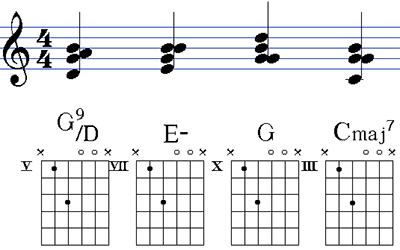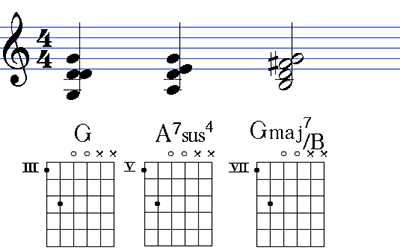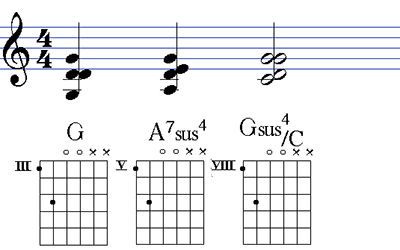A lot of people seem to have trouble coming up with their own melodies and chord progressions so today I want to show you one of my favourite – and probably most simple – methods :)
All you need is a guitar. You don’t need to be a particularly strong player, but you should be comfortable shifting your hand up and down the neck. We will be using open chords and fixed finger positions to create some interesting chord progressions.
Place your hand somewhere at or above the 5th fret of the guitar and choose one or two notes to hold down with your fingers. I usually make sure that the notes I press are within the same scale as the open strings I intend to use, but sometimes you can get nice effects if they are not.
If you are not sure, simply stick to any notes from the Em scale (E, F#, G, A, B, C, D) and you’ll be fine :)
Now strum or pick the notes you chose together with the open strings in an arbitrary rhythm. You might want to only strum some of the strings as too many different notes in one chord will make it sound muddy. In Example 1 below I am not playing the A string because it would add too much dissonance to the chords.
Finding a nice sound is all about experimentation. Never be afraid to just let your fingers fall wherever they want and just try it out! With time you will get better and better at having your fingers naturally find notes and chords that sound pleasant :)
From this initial chord, it is really simple to find follow up chords: simply shift your entire hand up or down the neck, keeping the relative finger positions and the open strings. Sometimes you might have to move a finger up or down by a fret when you shift your hand just to keep the notes within the scale and sometimes you might have to change your entire grip to something entirely different, but most of the time simply shifting your hand can give you some nice results.
Example 1 E|---0---0---0---0---0---0--- B|---0---0---0---0---0---0--- G|---8---4---6---8---11--9--- D|---9---5---7---9---12--10-- A|--------------------------- E|---------------------------
Notice that all I am doing in Example 1 is shifting my hand up and down the neck. My grip remains the same throughout. A modification of this method is to shift only a single note of the chord instead of the entire hand. This is most often done with the bass note of the chord as show in Example 2:
Example 2 E|--------------- B|---0---0---0--- G|---0---0---0--- D|---9---9---9--- A|---10--9---7--- E|---------------
This is a really simple approach, but can give you some nicely flowing chord progressions.
For the last example, let’s look at something a bit more complicated! In Example 3, I am not only shifting my hand, but I am also changing my grip each time to add more intricate elements to the chords. We could add even more detail to this pattern with hammer-ons and pull-offs.
Example 3 E|---0---0---3---2--- B|------------------- G|------------------- D|---5---4---2---4--- A|---7---5---3---5--- E|-------------------
I usually start with my hand at a fairly high position on the neck because I feel that it makes the notes under my fingers stand out in a nice contrast to the lower notes of the open strings. Furthermore, very simple picking patterns can sound quite elaborate because notes on consecutive strings are not necessarily in order of pitch.
And that is all ther is to this technique :) I like it for its simplicity and because it takes you away from playing the ‘standard’ chords you are usually taught when you start learning how to play.
To show you the power of this technique, I have created a little song example!
For the chords, I started off with a simple power chord on the 5th fret of the D string, leaving the 3rd and 4th string open, giving me a nice G9/D chord – that’s a G major chord with a 9th (A) and the D as the lowest note.
I then shift my hand up to the 7th, then the 10th and down to the 3rd fret to create my simple verse section:

I wasn’t too creative with the bridge. I wanted a similar feel, but with a little bit more power so all I did was change the picking pattern and move my hand down to the 3rd fret and across to the 6th string. I haven’t created a chorus yet, so the bridge just falls back to a small interlude section and then the song frament ends.


Here is the mixed song fragment! I hope you enjoy it :)




3 Responses
I love this method of composing. It always turns out something unique, sometimes usable. And I love getting semitone crunches in there with the open strings too.
I love this method of composing. It always turns out something unique, sometimes usable. And I love getting semitone crunches in there with the open strings too.
Same :) I haven’t done much music in a loooong time, but I always loved open chords to create some really unique melodies and chord progressions.